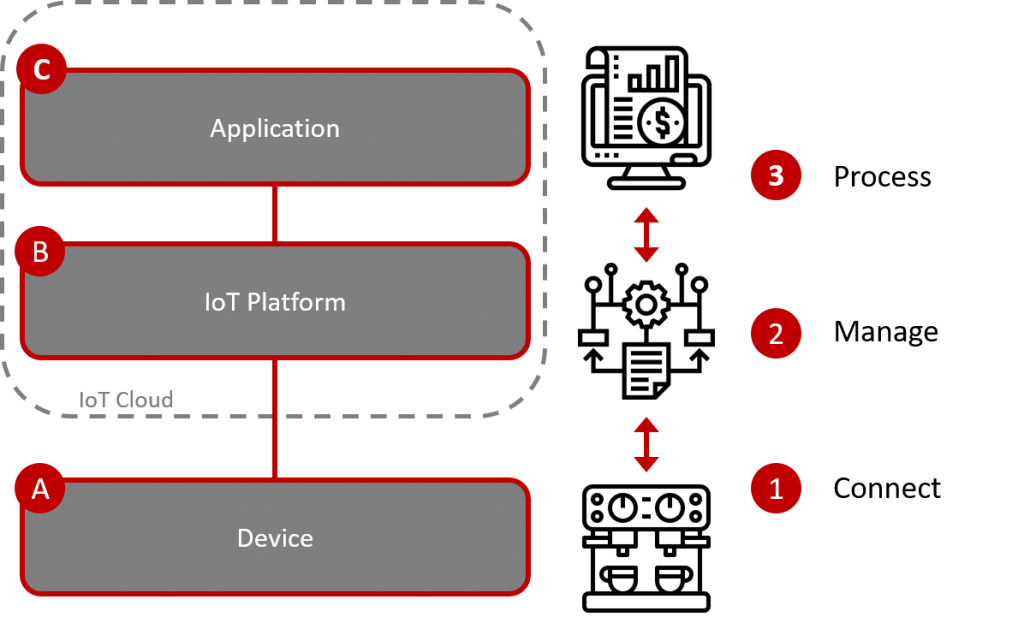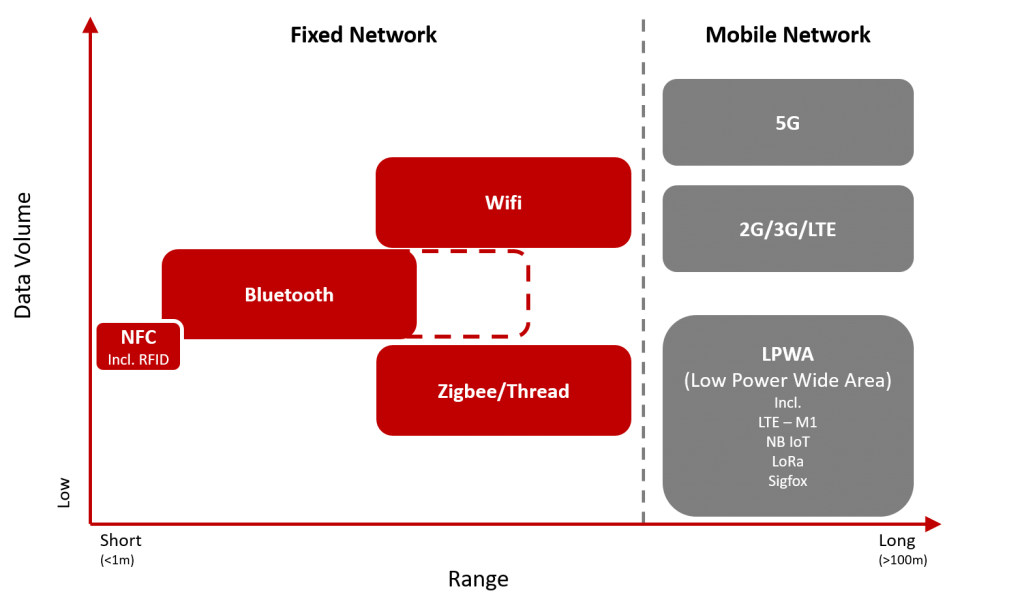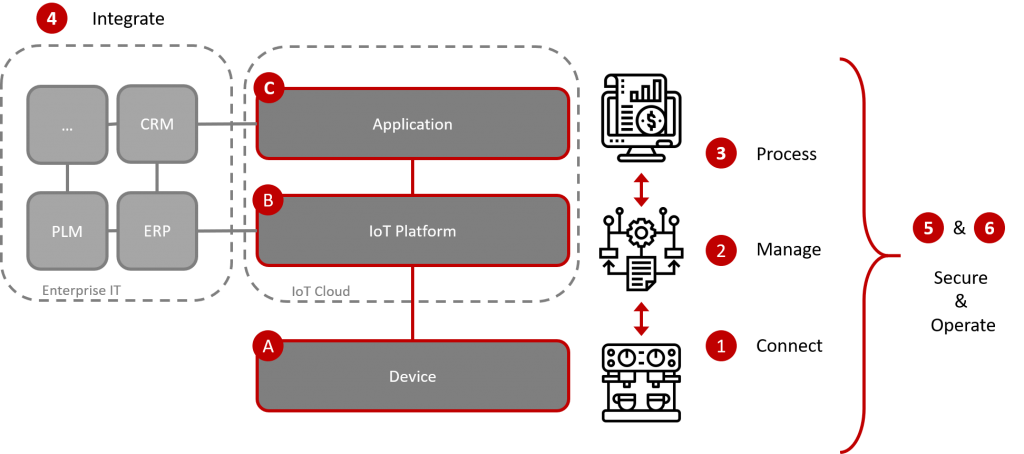IoT Solutions – structure and processes explained
A look behind the building blocks & processes that make our devices intelligent
Self-ordering refrigerators, coffee machines that report weeks in advance that parts need to be replaced and tractors that harvest fields on their own – the possibilities in IoT are as versatile as the industries and fields of application in which we manufacture products. But how is it possible that these machines are suddenly able to trigger orders or report their status independently?
Self-ordering refrigerators, coffee machines that report weeks in advance that parts need to be replaced and tractors that harvest fields on their own – the possibilities in IoT are as versatile as the industries and fields of application in which we manufacture products. But how is it possible that these machines are suddenly able to trigger orders or report their status independently?
Once we have understood the building blocks for an IoT solution to bring devices into the Internet of Things (IoT), we can start. So what exactly happens in IoT?
All IoT solutions typically have three main processes:
- Connect = Establish internet connection and send data
- Manage = Receive, structure, normalize, store and maintain data
- Process = Analyze and visualize data

Connect = Establish internet connection and send data
The first step is to connect the device to the internet so that it can send data. Similar to the way a smartphone can be connected via SIM, i.e. via a mobile internet connection or via WLAN, there are also various possibilities for IoT devices.
Before connecting the device, the following points should be clarified:
Can the device be connected to the Internet?
The first question is whether the device has a communication module. These are available for the different communication possibilities: For example, can it be connected via WLAN or LAN cable? Or does it have local data interfaces like Bluetooth or ZigBee? Or an integrated SIM module and supports mobile communication?
Can the device send (and receive) data?
If the device can be connected, it must then be able to generate messages and in the best case also receive them. So the question here is: Does the device have a (direct or indirect) communication interface? E.g. Direct: Does the device support IoT protocols such as MQTT, XMPP? or Indirect: can it be connected via field network such as ModBus, CANBus or OPC UA?
If the device is older and does not yet have a communication option:
Is a “retrofit” possible?
This means, can an additional communication module be added to send data?
For example, can a WLAN module or Bluetooth beacon be retrofitted to connect the device?
Which connection makes sense (for which Use Case)?
If a device is generally connectable, the question remains how (i.e. via which network and with which connection method) it should be connected.
Which network to choose (see Smartphone WLAN or mobile) depends first of all on the range that needs to be covered. Is the device mobile like e.g. a fitness watch that should work worldwide or is the device fixed in one place like a refrigerator?
The second factor is the data volume. Will the device send a few data points once a day, e.g. temperature and alarm data of a machine or live video data from a surveillance camera.
Once these two points have been clarified, one can limit which connection makes sense. The diagram below shows a simplified overview of the connection options:

Figure 2: Network options for IoT devices
Other factors in the selection are: Existing networks, e.g. is there a WLAN that can be used? Or are there reasons why it should not be used? (see Industry 4.0 ), How many devices should be connected via the connection? (network capacity), What is the network coverage in the region?, What is the power consumption of the devices for the connection?, Are there requirements for the transmission speed and reliability of the connection?
Manage = Receive, structure, normalize, store and maintain data
The first step is to make sure that the cloud can receive the data from the devices. Once the data has been sent over the selected network, the IoT platform must be able to accept and understand the data packages. The more different types of connected devices to be connected, the more IoT protocols and data types the platform must understand.
The structure of the data points varies from manufacturer to manufacturer and from device type to device type. Since this structure is completely different per device, they must first be structured and normalized once they are received in the cloud. You can imagine it’s similar to asking 10 people to draw a house: You get 10 different versions of a house. All pictures would show a house, but each person has his own way of drawing a house. Just like this every manufacturer has his own way of programming his device to send data. So it can happen that 10 different devices send, for example temperature data, in 10 different ways. Usually only the manufacturer himself knows how to evaluate this data. In some industries there are already common standards to simplify the data processing, for example the DICOM standard in the health sector. But in most industries there is no common standard yet. One of the main tasks in the development of an IoT solution is therefore the data normalization of the connected devices. This means in the example of the drawn houses, the system would first have to be taught that all 10 versions of the drawings represent a house. Or better said which part of the drawing represents the walls, windows, doors and the roof.
Process = Analyze and visualize data
Now it depends entirely on how the data is to be used. As already mentioned – the possibilities in IoT are as versatile as the industries and fields of application in which we manufacture products.
Take the coffee machine mentioned at the beginning as an example. Our Data Science Team might have found out from historical data that in >90% of cases a brewing group that heats up too hot leads to overheating of the machine and thus to its failure. The team is developing a rule or algorithm that monitors the brew group temperature during coffee preparation. The IoT platform would display the brew group temperature during each coffee preparation, compare it with the setpoint and store the result. If the algorithm detects over time that the brewing group temperature is steadily increasing or remains above the defined setpoint for a certain period of time, the system will issue a warning to have the brewing group checked before the machine breaks down. This would be one of the simplest forms of a predictive maintenance application.
In addition to the 3 core steps, there are 3 further important steps to build an overall IoT solution. Especially if you are trying to scale beyond simple pilot projects, they are an essential part of the development plan:
- Integrate = Connect further data sources and systems
- Secure = Creating security on all 3 levels: connecting, managing, processing
- Operate = Keep the IoT solution (processes 1. – 5.) running

Integrate = Connect further data sources and systems
To get the full value from IoT data, in most cases additional data sources are needed to put the data into context and automate processes. For example, external data sources such as weather data or raw material prices can be integrated to provide information on whether a change in temperature could be related to the outside temperature or whether energy costs could be saved by using less energy at a given time. But also your own IT systems such as the ERP system (where inventory data, invoice data and many other logistics and master data are stored) or the CRM system (where customer data, sales communication and sales forecasts are stored) should be connected in order to be able to invoice your IoT solution to a customer or compare the status of goods.
Secure = Creating security on all 3 levels: connecting, managing, processing
One of the biggest challenges is to secure the overall solution from device to application. Safety incidents can have devastating consequences, especially in areas of application that are critical to business (e.g. production control) but especially in applications that are critical to society (e.g. nuclear power plants, passenger aircraft or traffic control systems).
Especially at the platform level, many of the providers (such as Azure and AWS) already offer standard modules for securing IoT solutions (e.g. via PKIs). In the various industries there are also more and more startups that have specialized in securing IoT solutions. While these startups can credibly demonstrate the need for increased IoT security as the number of devices increases rapidly, the solutions they offer are currently still mainly silo solutions. These are difficult to integrate into an existing security landscape (e.g. existing SIEM systems).
Operate = Keep the IoT solution (processes 1. – 5.) running
Your solution is now in operation at your customers or in your own company. But who makes sure that everything runs smoothly? Who answers the phone when a customer reports a problem with the solution? Who solves the problem? Who improves the solution and ensures that you always work cost-efficiently? You need an operations team. You can set it up yourself or entrust it to an external partner.
You now know which components an IoT solution requires and understand the most important processes of an IoT solution. You are hereby now one of the <10% of German (or global) decision makers who know what IoT really means and how the building blocks and processes in IoT make our devices intelligent.

Comments are closed.